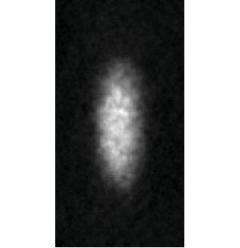January 10, 2011 feature
Physicists create sonic black hole in the lab

(PhysOrg.com) -- Black holes get their name because they absorb all incoming light, and are so dense that none of that light can escape their event horizon. In a new study, scientists have created a sonic analogue of a black hole in the lab – that is, a sonic black hole in which sound waves rather than light waves are absorbed and cannot escape. The scientists hope that the short-lived sonic black hole could allow them to observe and study the elusive Hawking radiation that is predicted to be emitted by traditional black holes, which has so far been a very difficult task.
The scientists, Oren Lahav and coauthors from the Technion-Israel Institute of Technology in Haifa, Israel, have published their study on the sonic black hole in a recent issue of Physical Review Letters.
The researchers created the sonic black hole in a Bose-Einstein condensate made of 100,000 rubidium atoms slowed to their lowest quantum state in a magnetic trap. This cold cluster of atoms acts like a single, large quantum mechanical object. In order to transform this condensate into a sonic black hole, the scientists had to find a way to accelerate some of the condensate to supersonic speeds so that the condensate would contain some regions of supersonic flow and some regions of subsonic flow.
The scientists achieved this acceleration by shining a large-diameter laser on the condensate in such a way as to create a steplike potential and a harmonic potential. When the condensate crosses the “step” in the steplike potential, the condensate accelerates to supersonic speeds. The scientists demonstrated that the condensate could accelerate to more than an order of magnitude faster than the speed of sound.
“The greatest significance of our article is that we succeeded in overcoming the Landau critical velocity, which states that flow cannot exceed the speed of sound,” coauthor Jeff Steinhauer of the Technion-Israel Institute of Technology told PhysOrg.com. “Our experiment exceeds this limit for a finite period of time.”
In this setup, the step marks the boundary between the supersonic and subsonic regions, which acts as the black hole’s event horizon. At this event horizon, the flow velocity of the condensate is exactly equal to the speed of sound. On the supersonic side of the step, the density of the condensate is much lower than that on the subsonic side. As the scientists explained, the low density corresponds to a higher flow velocity due to conservation of mass. In their experiments, they could maintain the black hole event horizon for at least 20 milliseconds before it became unstable.
Similar to how a black hole traps photons, the supersonic region of the sonic black hole can trap phonons and a wide range of other Bogoliubov excitations with a wavelength of between 1.6 and 18 micrometers. Excitations with very short wavelengths can escape, and those with longer wavelengths cannot fit in the supersonic region in the first place.
In the future, the scientists plan to use the sonic black hole to study Hawking radiation. As the physicist Stephen Hawking first predicted, black holes may emit a small amount of thermal radiation due to quantum effects. Losing this radiation can cause black holes to shrink and eventually evaporate completely. But so far, detecting this radiation has been very challenging.
In order to observe Hawking radiation in the case of the sonic black hole, there are a few requirements, such as that the trapped excitations must have negative energy. The researchers verified this in simulations: When focusing two laser beams with slightly different frequencies onto the supersonic region of the condensate, the simulated condensate absorbed a photon from one beam and emitted a photon into the second beam, creating an excitation with negative energy. In the future, the sonic black hole may give scientists a glimpse of Hawking radiation.
More information: Oren Lahav, et al. "Realization of a Sonic Black Hole Analog in a Bose-Einstein Condensate." Physical Review Letters 105, 240401 (2010). DOI:10.1103/PhysRevLett.105240401
Copyright 2010 PhysOrg.com.
All rights reserved. This material may not be published, broadcast, rewritten or redistributed in whole or part without the express written permission of PhysOrg.com.



















